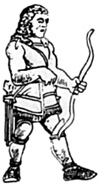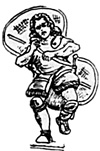 The original conception of Matrix Games grew out of a discussion on how one should game societies. The notion of "role playing" societies is intriguing but difficult to grasp. The argument method that MGs use, greatly simplifies the need to keep track of ever little detail of the society (as a number heavy system might have done). Yet the task still remains daunting. What factors of a society need to be kept track of? How do those parts fit together? How closely should they tie in with disciplines other than military history?
The original conception of Matrix Games grew out of a discussion on how one should game societies. The notion of "role playing" societies is intriguing but difficult to grasp. The argument method that MGs use, greatly simplifies the need to keep track of ever little detail of the society (as a number heavy system might have done). Yet the task still remains daunting. What factors of a society need to be kept track of? How do those parts fit together? How closely should they tie in with disciplines other than military history?
These thoughts have been bouncing about in my head for several years now. Enough time for me to form a few opinions. It's about time that they got a public airing. This forces me to crystalize my thinking before writing the next MG product.
I'll start with the last question first. Should the ideas tie in closely with disciplines other than military history? YES!!! In fact, military history tells very little about social structure. History, anthropology, sociology, political science, and criminal justice tell much more about the way things go together. Also other war games are useful in that some of the game mechanisms they use fit in nicely with what the other disciplines say.
It is clearly important to keep track of population. People are the building blocks of societies. It is important to show the division of labor somehow. It is important to keep track of food production in such a way that it is ignored unless it becomes critical. It is important to keep track of the political power groups with in the land, and the placement and control of troops. Wealth might be important, such as high prestige items, but again must require no thought to gamer unless it should become important. All of the above must connect easily with standard maps (so that the notions can be easily generalized to other games.
Simple. Well ... Er ... Maybe
Population is at least simply dealt with. Since civilization began, societies have been formed into hierarchical pyramids. The 75% on the bottom consisting of peasants (or as high as 90% during dark ages). The 20% on the next tire make up the urban workers, craftsmen, merchants, and bureaucrats (the middle class). The remaining 5% of the people are on top of the pyramid. They consist of soldiers and priests. Periodically, the holy men and the military men content with one another over who is on top, but in general society remains the same. Until the Industrial Revolution that is. Now all bets on a static basically unchanging social structure are off.
So society can be broken down into a pyramid, that not coincidentally corresponds with the division of labor and social classes. Consider the following society.
Craftsman Scribe Farmer Farmer Farmer
Farmer Farmer Farmer Farmer
This is a picture Of Ancient Egypt, about the time of the construction of the pyramids. farmers plow the land, artisans make weapons and prestige items for the King. Scribes record and administer thc lands, and the King rules over them all. Sometimes he has to use military force to get people working. But bullying peasants is not so hard. The middle class, have an interest in keeping things stable so they are easily handled. Power is divided into a reverse pyramid that might look like this...
Monopoly on weapons, Monopoly on prestige/wealth, Monopoly on divine power
Makes things, Is literate, Creativity
Grows the food
So if the power in the society were to be divided up according to the above pyramid, the then King has 75% of all the power, the crafts men have 5 to 10% of the power, the scribes have 10 to 15 % of the power, with the peasants having maybe 5% of the power. This might be broken down into political power groups like the following.
| The Priest King himself | 10 units of power | 50% of the total |
| The Chief Priest | 2 units or power | 5% of the total |
| The Crown Prince | 2 units of power | 5% of the total |
| The Queen | 2 units of power | 5% of the total |
| Powerful Nobles | 2 units of power | 5% of the power |
| The College of Scribes | 6 units of power | 15% of the power |
| The Craft Guilds | 2 units of power | 5% of the power |
| Peasants | 2 units of power | 5% of the power |
The division of power could be easily altered. It is a zero sum game. Take someone else's power to increase one's own. Or new power could be added to the total, which will change the percentage split of power. Either way, this show who makes the decisions. Power could be interpreted as votes. The King only has to get one other power group to side with him, to be able to win any vote. Consequently he makes all the decisions in the land without much need to consult populous.
 The problem with food long stumped me. Clearly peasants grow the food. But if one has to keep
track of "food production points" then just quit the game now, before the headache. There is a simpler answer. Assume for the moment, that the peasants feed themselves regardless of what society does. That means that all that need be taken care of is surplus production. Say one peasant produces one unit of surplus food. That would have the above Egypt with a surplus of seven.
The problem with food long stumped me. Clearly peasants grow the food. But if one has to keep
track of "food production points" then just quit the game now, before the headache. There is a simpler answer. Assume for the moment, that the peasants feed themselves regardless of what society does. That means that all that need be taken care of is surplus production. Say one peasant produces one unit of surplus food. That would have the above Egypt with a surplus of seven.
If it only takes one unit of food to feed a higher tire group (the king, the scribes and the artisans) then Egypt still has four units left over. Maybe these could be stored for the seven lean years of the Bible, or maybe they could be used to feed four armies, or to build a pyramid, or some other major activity. The artisan's production could be kept track of in the same manner, it is a surplus that can be used for a project or stored for a rainy day. Or perhaps there should be a limit on storing surplus, make it a use it or lose it proposition. That cuts down on the paper work.
Since societies grow, it makes since that the pyramids used to represent them should change as well. So if population grew by one every turn that everyone was fed, the society might grow as follows.
Peasant Peasant
Priest
Peasant Peasant
Priest
Artisan
Peasant Peasant
Priest
Artisan
Peasant Peasant Peasant
Priest
Artisan Scribe
Peasant Peasant Peasant
It makes since that if Egypt has its own pyramid, the other societies probably have their own structures as well (maybe a ziggurat in Sumeria, or a pagoda in China). In fact, each province should have its own social pyramid. The last mentioned three tired pyramid in the Egyptian growth sequence above, might be considered the capital at Thebes. The other areas of the country might consist of only one peasant each. Should they be taken by an invader, or wrecked by disaster, then the city state of Thebes would be fine, due to having enough peasant to feed itself.
Articulation
That leads into the question of articulation. How does society fit together when a famine strikes'? Do people starve? If so, who? If they do, how does it effect the pyramid, division of labor and political power? And how do armies, (the bringers of disasters) fit into the pyramid?
It does not make since to include armies into the population pyramid since soldiers are frequently peasants or part of a ruling elite. They seldom comprise more than 2% of the population, and produce nothing. Military power seems best assigned to the power division inverted pyramid. Control of the military is one reason why the King has so many power points. Though small, armies do eat a lot, so having one army eat one surplus unit of food makes since (so that there is a natural cap on the number of' units a country can have that is tied to a real limiting factor).
Disasters are more problematic. They beg the question of when does a society collapse due to its troubles? I have no answer to this question. It may be helpful to look back at the very structure of thc pyramid. Say there was a disaster the killed off the top wrung of the pyramid.
Peasant Peasant Peasant
This is equivalent of what happened in the Aztec and Incan Empires. The Spaniards moved into the vacant power positions and life went on as before. (Save that all the wealth started being shipped back to Spain rather than being kept locally). Or What would a famine that killed one peasant look like'?
Artisan Scribe
Peasant Peasant
There would only be two units of surplus food. Unless other food could be brought in, then the Artisans would stop worlk and grow food to feed themselves. Maybe they would do this tor one turn, but then they would become peasant rather than continue to starve in the city.
Scribe
Artisan Peasant Peasant
King
Scribe
Peasant Peasant Peasant
I imagine lots of permutations like the above can be found out. One thought that I've had from this is to look at the structural integrity of a pyramid, to describe its problems. For instance
Artisan Scribe
Peasant Peasant Peasant
Peasant Peasant
This structure is top heavy, It lacks proper foundation, and will soon fall.
Artisan Scribe
Peasant Peasant
This structure can feed itself, but is too tall. It also has a conflict built into the top wrung as to who is in charge. Clearly the idea needs more work. But I'm beginning to see how it might end up working out. A country could be describe by an atlas of provincial pyramids that say who lives there, what they do, what is power, and who controls it. Such an atlas would become a major part of the "matrix" of an MG.
Back to MWAN #85 Table of Contents
© Copyright 1997 Hal Thinglum
This article appears in MagWeb (Magazine Web) on the Internet World Wide Web.
Other military history articles and gaming articles are available at http://www.magweb.com